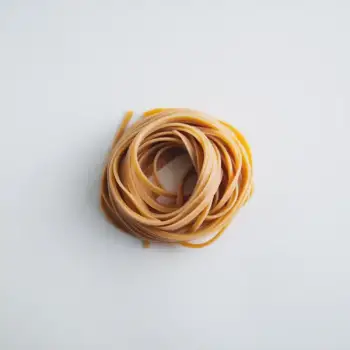Tagliatelle and Pappardelle are both types of pasta with Tagliatelle being narrower, ideal for delicate, creamy sauces, and Pappardelle being wider, perfect for hearty, thick sauces. They are versatile in various dishes, including traditional Italian and modern fusion, and can be used in vegetarian and vegan recipes.

Tagliatelle is a traditional type of pasta from the Emilia-Romagna and Marche regions of Italy. These long, flat ribbons are typically about 6-10 mm wide and are known for their porous and textured surface that excellently clings to sauces.

Pappardelle is a wider style of pasta, similar to Tagliatelle, originating from Tuscany. The ribbons are broader, usually measuring over 13 mm, and have a luxurious feel that pairs perfectly with hearty sauces and ragùs.
The main differences lie in width, with Pappardelle being wider than Tagliatelle. This influences the texture and sauce pairing, with Pappardelle offering a more substantial bite and being suited for thicker, heavier sauces, while Tagliatelle works well with more delicate, creamy sauces.

Your ultimate Recipe Box, Meal Planner, and Cooking Class all in one
In Bolognese dishes, Tagliatelle is a classic choice. The pasta's surface allows the meaty sauce to adhere well, promising a balanced bite. Tagliatelle al tartufo, featuring truffle, is another dish where its delicate nature is appreciated. When using Tagliatelle, ensure the sauce is not too heavy to maintain the pasta's integrity. Pappardelle shines in Tuscan recipes like Pappardelle al cinghiale, where its broad surface stands up to the robust, gamey flavors of wild boar ragù. It’s also preferred in recipes with thick vegetable or porcini mushroom sauces. When using Pappardelle, cook it al dente to maintain its satisfying texture.
Modern fusion kitchens might use Tagliatelle in East-meets-West dishes, pairing it with lighter Asian-flavored cream sauces or incorporating it into seafood dishes. The key is to balance the pasta's texture with complementary, not overpowering, flavors. For heartier fusion dishes, such as those with braised meats or richly spiced sauces, Pappardelle offers the perfect base. Its broad surface can handle the weight and complexity of fusion sauces, making it a go-to for innovative, bold recipes.
Tagliatella is ideal for vegetarian pesto-based dishes or lighter veggie cream sauces. Its slender form wraps elegantly around vegetables, allowing for a harmonious blend of pasta and fresh garden flavors. Pappardelle pairs nicely with chunkier vegetable ragùs or vegan bolognese made with lentils or meat substitutes. Its width is perfect for capturing the essence of the vegetables and creating a satisfying meat-free meal.
Both Tagliatelle and Pappardelle carry similar nutritional profiles, with the main differences being portion size due to their width. Adjust serving sizes accordingly to maintain nutritional balance.
| Nutrient | Pappardelle ( per 100g ) | Tagliatelle ( per 100g ) |
|---|---|---|
| Fat | 1.7g | 1.5g |
| Fiber | 3.3g | 3.2g |
| Sodium | 6mg | 7mg |
| Protein | 12.4g | 12.5g |
| Calories | 359 | 355 |
| Carbohydrates | 72.2g | 71.7g |
Yes, but the final dish will have a different texture due to the width of Pappardelle. It may also require a slightly longer cooking time to reach al dente.
Tagliatelle is generally better for creamy sauces as its narrower width complements the delicacy of such sauces.
Consider the sauce and accompanying ingredients. Lighter, more delicate sauces and ingredients pair well with Tagliatelle, while heartier, robust sauces are better suited for Pappardelle.
Absolutely. Both pastas can be used in vegetarian or vegan dishes, depending on the sauce and accompaniments chosen.
Pappardelle typically requires a slightly longer cooking time due to its width. Start by following the package instructions and adjust as needed, tasting for al dente texture.